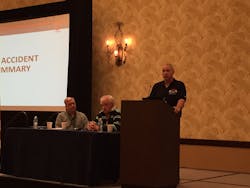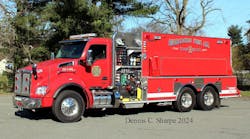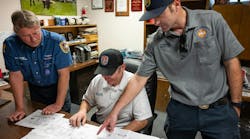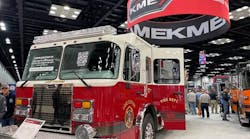Boston Fire Department has struggled with fire apparatus issues since Commissioner Leo Stapleton retired in 1993. At the recent Fire Department Safety Officers Association (FDSOA) 29th Annual Apparatus Symposium in Orlando, BFD’s Robert Calobrisi, deputy fire chief, Lt. James O’Brien and Ralph Craven, consultant to BFD, presented a brief history of Boston’s apparatus problems and the steps to bring BFD into this century.
Calobrisi began with the story of Boston’s Ladder 26. In 2009, the ladder was coming down a hill in a 25 mph zone. The driver told Lt. Kevin M. Kelley the vehicle had no brakes. After failed attempts to slow or stop the ladder, Kelly advised the crew to brace for crash and went into a building at 57 mph, killing Lt. Kelly and injury children in the building.
“From the time they descended from the hill to the time they struck the building across the intersection it was 20 seconds,” said Calobrisi.
“Seatbelts, seatbelts, seatbelts,” Calobrisi emphasized. “The state of Massachusetts waived the seatbelt rule for public safety. Why? If we can’t get to the incident safely in once piece, what can we do? Safety for other people is a priority, but we got to get there safely too.”
Calobrisi detailed the after-accident history, including formation of a Board of Inquiry with eleven members. Calobrisi was put in charge of the inquiry. Their goal was to identify one of their own was killed needlessly.
“We expect death on the fire ground, we know that when we sign on, but it shouldn’t happen like this,” Calobrisi said.
The committee’s findings listed possible causes of the L-26 accident including: brake failure, frozen brake lines, insufficient maintenance of L-26’s air supply, air compressor and air reservoir tanks.
Further investigation by the committee found a series omissions or failures including lack of daily apparatus inspection programs and inadequate driver training. In addition, the committee noted the installation of non-compatible parts by outside vendors, lack of emergency vehicle technicians, and funding for P.M. programs. In 1993, BFD had 16 mechanics in the shops and in 2008 there were 7. Record keeping was nonexistent and there was no structural apparatus replacement plan.
After Stapleton retired, the new administration during 1994 to 2009 was referred to as “The Bear Market.” L-26 was 13.5 years old, had responded to 49,000 incidents and had over 100,000 miles. “Should L-26 have been a frontline piece of apparatus in 2010?” Calobrisi asked. Years 2010-2015 was considered “reactive recovery” by many in the department.
“See a trend here? Shortage-shortage-shortage,” said the chief. Over 32 pieces of apparatus were purchased, but BFD was still short 57 pieces of apparatus making the average age of Boston’s apparatus 16 years old.
In January 2015, Commissioner Joe Finn appointed a new Apparatus Committee consisting of a deputy fire chief, a chief of operations, a fleet director (a deputy chief) and a fleet manager. The committee’s mission was “to make recommendations regarding the design and performance of new Boston Fire apparatus by developing specifics for competitive bid.”
Calobrisi referred to the 2016 to 2024 as “The Bull Market.” The council of Boston’s purchasing department has approved the purchase of 48 engines; 30 ladders, one tower ladder and one heavy rescue, for an average of 8.8 pieces of apparatus/year and surplus of 2.8/year.
“If the above purchase plan is executed, the average age of BFD apparatus in 2024 will be 6.6 years,” Calobrisi added. “What could be better than retiring with a healthy fleet, serving the city of Boston? I don’t think anything could be better.”
With a new mayor and fire commissioner in Boston, it was time to tackle the problems with Boston’s apparatus and in the shops. Commissioner Finn asked Ralph Craven to do a fleet assessment of Boston’s shops.
Ralph Craven was hired as a consultant to review and make recommendations on the Boston Fire Department’s fleet. He has a long history in the fire apparatus industry and was one of the founding members of the National Association of Emergency Vehicle Technicians. Craven also was involved in initial efforts to create a certification program and raise the professional standards of mechanics to EVTs. In 1998, Craven appeared in the investigation for Dateline about Houston Fire Department’s apparatus issues.
In November 2015, Craven planned to do the fleet assessment, meet with the fire department staff and do the assessment in two phases; first, an initial evaluation, make recommendations, and then return in 90 days for the second phase to see what was done.
During Phase I, Craven reviewed a 2009 consultant’s report completed after Lt. Kelly’s death and would identify critical issues to determine what was going on now. When Craven arrived at the shops to do Phase 1, he found that the director of the fleet was on vacation. After reviewing the 2009 consultant’s report and the 12 recommendations, Craven found that as of 2015 only two recommendations had been implemented.
In the initial review, Commissioner Finn assigned Lt. James O’Brien to assist Craven. They walked the shops where 11-14 mechanics were working. “Where they live is going to impact where they work,” said Craven.
The Fleet Safety Coordinator and Craven reviewed shop documents and records and that’s when Craven found out the department wasn’t billing the manufacturers for warranty work. The coordinator said they charge $25 an hour for warranty work, however—they had failed to bill the manufacturer for reimbursement on warranty work.
Craven toured the facility and grounds. He found a $200,000 service vehicle parked and had never been used. An air filter recycle systems (DEF cleaner) was not even hooked up and the explanation was, “There wasn’t enough power in the building.” Craven said, “They spent $10,000 on a machine that was never used.”
Craven added, “The best thing they did do was contract with a parts company that stocked and manage it with their own employees. They knew their business and it was an excellent program.”
The shop was staffed 24/7 with two people on overtime during the night. “Guess what they were doing when they had to work a shift during the day?” asked Craven.
Fleet maintenance did have a computer system to manage the fleet, however there was no data available because the director didn’t know how to use the system. Craven asked to see the forms for a mechanic and he received a time card in response.
“How do you determine a mechanic’s productivity when you don’t document it?” Craven said. “There were no written policies on how to do things in the shop. I know it’s a bureaucracy, but if you have 25-30 people working for you, you have got to have it written down how things are done,” he said.
In Phase 1 there were no daily maintenance checks. Craven saw trucks that had not been inspected in over 200 days. He also found numerous inaccuracies including specs that required Cummins’ engines, but the fleet director changed to Maxx force without any notice.
Among Craven’s Phase 1 recommendations: create a separate fleet maintenance division and insist person with fire background be in charge of the fleet. (Lt. James O’brien was made Fleet Manager)
Get a software program and everybody needs to know how to use it. Craven made a total of eight recommendations and would return in 90 days.
Ninety days later, Craven returned for Phase 2 and found new employees and with a different union. He found a problem with the door latches on the trucks that were a safety issue. A NHTSA recall check however, revealed that there was also a steering problem, that Craven was told was repaired, but wasn’t.
In developing a Master Plan, Craven and the team has included technician training, technician retention issues, and organizational structure. He also is implementing a strict PM Program and workplace safety.
“We can’t have trucks on the street running around that haven’t been inspected for 200 days.”
Lt. Jim O’Brien was cut short due to time constraints, but is expected to be part of the 2018 Apparatus Symposium in Scottsdale with a comprehensive update on Boston Fire Department’s shops and apparatus.






